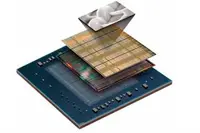Electronics News
Archive : 2 July 2015 год
 University of Southampton researchers are to trial new techniques to produce optical fibre using additive manufacturing. This new way of making fibre could pave the way for more complex structures capable of unlocking applications in a range of industries, from biotechnology to aerospace and telecommunications.
University of Southampton researchers are to trial new techniques to produce optical fibre using additive manufacturing. This new way of making fibre could pave the way for more complex structures capable of unlocking applications in a range of industries, from biotechnology to aerospace and telecommunications.
Current techniques used to produce optical fibre preforms give a consistent structure along the length of the preform but make it difficult to control the shape and composition of the fibre in 3D. This limits the degree of flexibility in the design of the fibre and consequently, the capabilities that the fibres can offer.
The technique, being developed by Professor Jayanta Sahu, his colleagues from the University of Southampton's Zepler Institute and the Faculty of Engineering and Environment, will allow engineers to manufacture preforms with complex structures and different features along their lengths.
"We will design, fabricate and employ multiple materials additive manufacturing equipment to enable us to make optical fibre preforms in silica and other host glass materials," Prof Sahu said: "Our proposed process can be utilised to produce complex preforms, which are otherwise too difficult, too time-consuming or currently impossible to be achieved by existing fabrication techniques."
Currently, most microstructured fibres are made using the 'stack and draw' process which involves stacking several smaller glass capillaries or canes together by hand to create the preform. However, using the additive manufacturing technique, the researchers say they will be able to form complex fibre structures layer-by-layer, gradually building up the shape to create a preform several tens of centimetres in length.
Prof Sahu added: "This is something that has never been tried before and we are excited about starting this project."
Author
Tom Austin-Morgan
Source: www.newelectronics.co.uk
 Xilinx has taped out an UltraScale+ MPSoC on TSMC's 16FF+ process, an event that appears to be adhering to the schedule outlined by the company earlier this year.
Xilinx has taped out an UltraScale+ MPSoC on TSMC's 16FF+ process, an event that appears to be adhering to the schedule outlined by the company earlier this year.
The part integrates seven user programmable processors, including a quad core 64bit Cortex-A53 application processing unit, a dual core 32bit Cortex-R5 real time processing unit and a Mali-400 graphics processing unit, with a range of peripherals, safety and security, and power management features. Target applications are said to include embedded vision, ADAS and autonomous vehicles, the industrial Internet of Things and 5G wireless systems.
When the UltraScale+ range was unveiled in February 2015, Xilinx claimed early customer engagements were in process and that it expected to tape out the first parts in Q2 2015, with the first shipments towards the end of 2015.
Author
Graham Pitcher
Source: www.newelectronics.co.uk
 GreenPeak Technologies has announced the GP712, said to be the industry's first single radio multi-protocol chipset with multi-channel receive capability for set-top boxes, gateways, and other advanced IoT devices.
GreenPeak Technologies has announced the GP712, said to be the industry's first single radio multi-protocol chipset with multi-channel receive capability for set-top boxes, gateways, and other advanced IoT devices.
As ZigBee is the dominant communication technology for wireless sensor networks and Thread is expected to become a prevailing player in the same IoT communication space. GreenPeak claims that application developers and device manufacturers will need a future-proof solution that can combine both communication protocols for connected home applications.
With the GP712, GreenPeak adds its multi-channel receive feature that allows simultaneous listening for both ZigBee and Thread packets using a single radio. This is said to be a major cost reduction for designing future-proof set-top boxes or gateways. Furthermore, GreenPeak says it has improved its frequency agility mechanism to provide enhanced co-existence of the various applications with other 2.4GHz wireless communication systems
"In order to support both communication technologies, the GP712 supports the two protocols in a single package," said Cees Links, GreenPeak's CEO.
"It provides a multi-channel and multi-protocol solution for concurrent, transparent and complimentary ZigBee and Thread network application processing, all in the same design, at no extra cost."
The GP712 comes in a 24-pin QFN package.
Pic: Cees Links, ceo of GreenPeaks
Author
Tom Austin-Morgan
Source: www.newelectronics.co.uk

